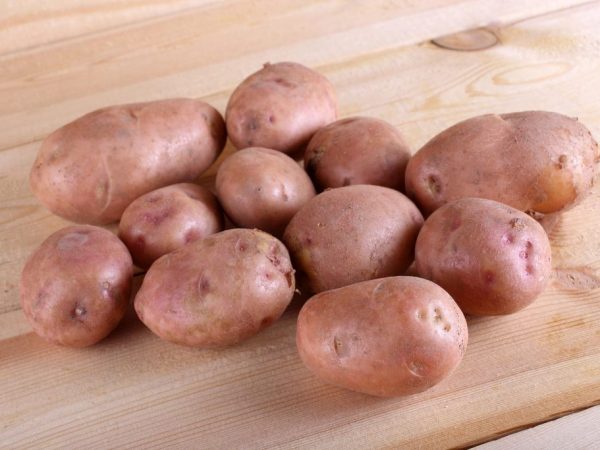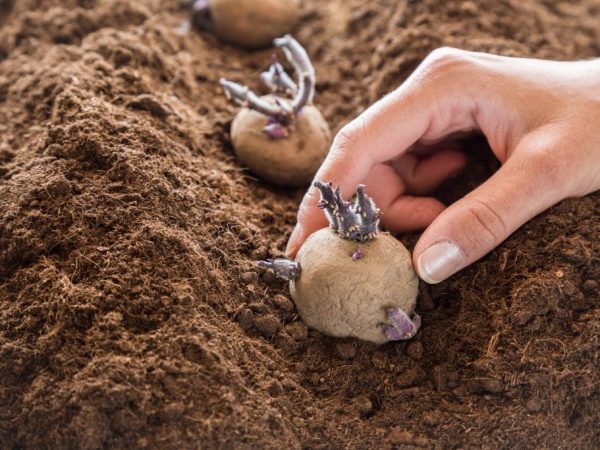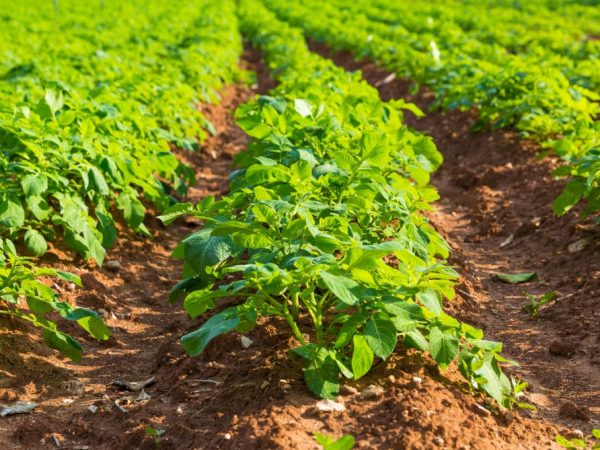Description of Sineglazka potatoes
Potatoes are one of the most sought-after crops in the world. Not only high-yielding hybrids deserve special attention, but also domestic varieties, for example, Sineglazka potatoes. It is a versatile variety that can be used for excellent purée and frying.

Description of Sineglazka potatoes
Description
Unfortunately, today many domestic varieties, among them Sineglazka potatoes, are quite difficult to find. With an eternal desire to get closer to European standards, our farming works at a loss. Initially, the variety was bred for individual cultivation, back in the USSR.
Description of the domestic variety Sineglazka:
- mid-season species, ripening period varies from 80-100 days;
- not suitable for northern regions;
- tall, spreading bush;
- inflorescences of a lilac shade with yellow cores;
- ripe potato reaches 200g;
- the peel has a rough structure, is painted in a dark color with a blue tint;
- eyes are compact blue;
- the pulp is white.
Due to its relatively low starch content, it has good taste. This allows you to use it for business. The Sineglazka potato variety gives an excellent harvest on any type of soil.
Qualitative indicators
From 1 hectare you can harvest 400-500 kg of excellent potatoes. The tubers are medium in size, under adverse weather conditions and improper care, the potatoes will be small. Quality indicators will largely depend on the planting material and soil nutrition.
Due to the not too high starch content, the potatoes are perfectly boiled and absorbed by the body. It is recommended for dietary and baby food, while most varieties are not suitable for people with gastrointestinal problems. Its excellent taste has made it very popular among gardeners.
Growing

Planting potatoes, preferably before mid-May
Pick up times will vary by region and weather conditions. Root crops are usually planted until mid-May. To get a harvest quickly, the plantings are covered with foil.
Potatoes of this variety can be planted, germinated and without prior germination. To get a healthy harvest, it is best to use the germination method. In addition, seed should be treated against pests and fungi.
The soil
For planting, it is preferable to choose the following types of soil:
- sandy;
- sandy loam;
- light loamy with a neutral environment.
Preparation is carried out after harvest. Initially, you should outline a place for planting, remove the tops and plow the area. Like all varieties, this variety responds well to fertilization. In the autumn, organic matter is introduced. If you can't get good compost, you can use mineral fertilizers.
By the spring, after lying in the ground for several months, fertilizers are transformed into a form that is well assimilated for plants.In the spring, organic matter is applied again, a month before planting. Potatoes do not like water stagnation, therefore, with close contact of groundwater, good drainage should be ensured.
Seed preparation
It is better to carry out planting with germinated material, but you can not do this, then you will not have to wait for the last frosts and complete heating of the soil. Disembarkation can be carried out as early as mid-April, in warm regions, even earlier. The main thing is to cover the planting with covering material. This will evenly warm up the soil mixture and protect the seedlings from temperature extremes. With this option for planting, the crop will be obtained earlier, but there is no guarantee that it will be possible to preserve it.
The most commonly used method is pre-germination. From the cellar, the potatoes are laid out in a warm, well-lit room. Do this a month before planting. It is possible to plant potatoes when sprouts appear 3-5 cm in size. Culling is carried out first, all tubers with thin filamentous sprouts are removed.
Another important step in seed preparation is dressing. To do this, use a solution of manganese or special insecticides, which provide reliable protection against late blight and all kinds of pests. You can spray the tubers with a solution directly in the hole or pickle and dry it in advance.
Disembarkation
The holes are made in 50 cm increments, because the ground part of the blue-eyed is quite large. The distance between the rows is 70 cm. The more space the bushes have, the better the root system will develop.
Root crops are planted to a depth of 12 cm. After that, the holes are buried and the territory is shielded. In the future, you need to ensure that the soil does not dry out and is not too wet.
How to care

The soil must be loosened regularly
Sineglazka potato variety and characteristics of further stages of care:
- loosening the soil;
- fertilization;
- irrigation system;
- hilling.
The soil should be loosened and freed from weeds when the potatoes release strong shoots. In the same period, fertilizers must be applied. In the early stages of growth, nitrogen is the key element for optimal development. You can use high-quality mullein, urea, herbal infusions.
Not all farmers practice hilling, but in wet weather this method is still worth using. The procedure will be ineffective only in too hot climate. In other cases, it is carried out twice within 1.5 months from the moment the shoots appear 12 cm. If the soil is too wet, the inter-row space is cultivated 10 cm deep, sometimes even deeper, depending on the moisture level.
The drip irrigation system allows you to save valuable time and keep the crop from drying out. If the ground part grows too quickly, you should stop the introduction of nutrients once. If diseases of the culture are detected at later stages, it is recommended to use insecticides for their effective elimination.
Collection and storage
As soon as the tops began to dry out and acquire a yellowish tint, it means that it's time to harvest. During this period, it is recommended to remove the tops, and only after 10 days start digging. During this time, the tubers will fully ripen.
Do not clean after rain or watering. Better to pick a windy, warm day. Having dug up the potatoes, they should be laid out on the ground and allowed to air thoroughly. It is not recommended to immediately send it to the cellar after collection. To begin with, the potatoes are sorted, and then laid out in boxes and left to stand in a dark room for 3 weeks. After that, rejection is carried out again and sent to a potato storage, with an air temperature of 2-4 ℃.
Sineglazka potatoes do not have a good keeping quality, so they should be stored in a spacious room. Throughout the entire shelf life, tubers need to be sorted out, rotted away.It is advisable to store root vegetables in wooden boxes.
What is Sineglazka sick with?
Sineglazka potatoes - the characteristics of the diseases are presented below.
- Phomosis - the first symptoms appear during the flowering stage. First, fungal spores infect the petiole at the base, then spread to the tubers. In order to prevent the seed material, it is recommended to process it before planting.
- Mosaic - dry rot affects the leaves at the budding stage. As a result, the ground part ceases to feed the rhizome and the plant dies. For prevention purposes, seed material with filamentous sprouts should be discarded and the condition of the seedlings should be monitored.
- The potato moth lays its eggs on the lower leaves. After hatching, caterpillars eat foliage and petiole, tubers, if they are located close to the surface of the earth. The use of pheromone traps can effectively fight moths and prevent them from laying eggs.
- Wireworm, bear and Colorado potato beetle are the main pests of all types of potato crops. To combat them, insecticides are used. It is recommended to carry out seed treatment at the planting stage.
Almost all diseases and pests are associated with improper care. If you fulfill all agrotechnical requirements even at the stage of laying seeds in the ground, you can avoid many problems in the future. In addition to chemical treatment, folk methods of plant treatment are often used to destroy fungus and pests. An effective remedy is all kinds of herbal decoctions and garlic. The selection of quality seeds is the key to a healthy harvest.
Final part
The Sineglazka potato was bred about 50 years ago. Due to its excellent taste and high yield, it has become widespread in the territory of the post-Soviet space. With all its positive qualities, the variety has many disadvantages, which drove it out of the world market.
Potatoes begin to bear fruit in June, and the growing season lasts until the end of August. This makes it unsuitable for long-term storage. Another disadvantage is the need for constant replacement of seed material. For planting, it is recommended to use the seeds rather than the tubers themselves, or buy seed potatoes every year from different breeders. Despite all these shortcomings, farmers, who have tried the taste of excellent potatoes, continue to grow them on their plots.


